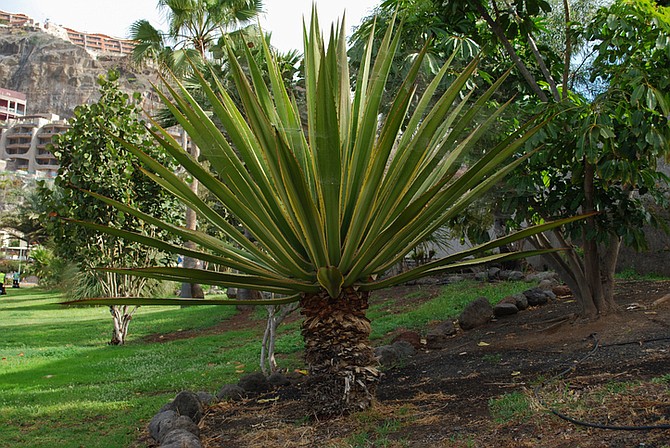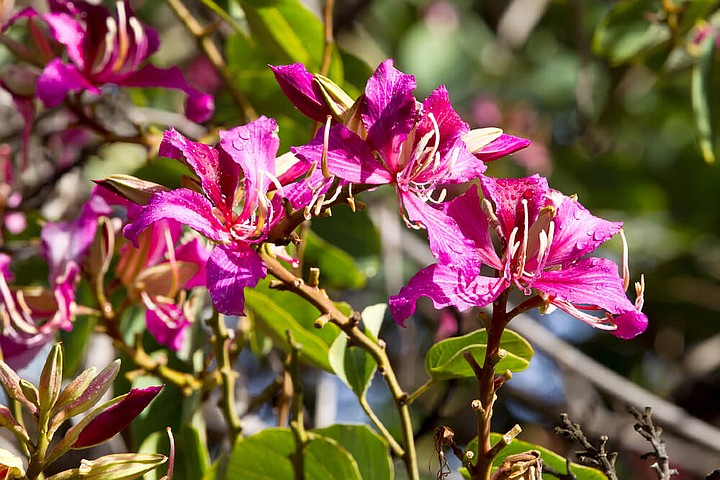 Facebook
Facebook
 X
X
 Instagram
Instagram
 TikTok
TikTok
 Youtube
Youtube

Yuccas of two varieties are in bloom in San Diego County from now through May. Year after year, the Mojave yucca (Yucca schidigera) sends up a blunt flower stalk of white, waxy blossoms from the same base — a rosette of daggerlike leaves. The shimmering white exclamation point that unfolds above “our Lord’s candle” (Yucca whipplei), on the other hand, is a prelude to the plant’s imminent death. Mojave yucca is widely distributed along San Diego County’s coastal strip and throughout the higher elevations of the Anza-Borrego Desert. Our Lord’s candle prefers the scrubby coastal foothills and the drier slopes of the Palomar, Cuyamaca, and Laguna Mountains. The two yuccas coexist with each other in a few areas like Torrey Pines State Reserve and Anza-Borrego’s Culp Valley area.

Orchid Trees, now at their flamboyant best in front yards and public spaces throughout the city, are showing off their large, orchidlike flowers in shades of pink, purple, and maroon. Orchid trees thrive in areas with a mild winter climate, hence their popularity in Hawaii, Southern California, and Arizona.
Longer and Sunnier Days this late-winter season are triggering the emergence of bright green leaves on sycamore, liquidambar, and other decorative deciduous trees around San Diego. Cruise down 163 through Balboa Park to appreciate the vernal splendor of the sycamores growing in the landscaped center divider. Or walk across the Cabrillo Bridge and look down upon the same.
Earth crosses the March equinox point on its orbit at 5:37 a.m. EDT on this date. This when the Sun crosses the equator (both Earth's equator and, equivalently, the celestial equator), heading north. Spring begins in the Northern Hemisphere, fall in the Southern Hemisphere. And no, eggs don't balance today any better than they usually do, in case someone tries to tell you that.
By nightfall, the Big Dipper is high in the northeast and beginning to tip left. Look left of its center, by about three fists at arm's length, for Polaris in the dim Little Dipper. Other than Polaris, all you may see of the Little Dipper through light pollution are the two stars forming the outer edge of its bowl: Kochab (similar to Polaris in brightness) and below it, fainter Pherkad. Find these two "Guardians of the Pole" to Polaris's lower right by about a fist and a half at arm's length.
The above comes from the Outdoors listings in the Reader compiled by Jerry Schad, author of Afoot & Afield in San Diego County. Schad died in 2011. Planet information from SkyandTelescope.org.


Yuccas of two varieties are in bloom in San Diego County from now through May. Year after year, the Mojave yucca (Yucca schidigera) sends up a blunt flower stalk of white, waxy blossoms from the same base — a rosette of daggerlike leaves. The shimmering white exclamation point that unfolds above “our Lord’s candle” (Yucca whipplei), on the other hand, is a prelude to the plant’s imminent death. Mojave yucca is widely distributed along San Diego County’s coastal strip and throughout the higher elevations of the Anza-Borrego Desert. Our Lord’s candle prefers the scrubby coastal foothills and the drier slopes of the Palomar, Cuyamaca, and Laguna Mountains. The two yuccas coexist with each other in a few areas like Torrey Pines State Reserve and Anza-Borrego’s Culp Valley area.

Orchid Trees, now at their flamboyant best in front yards and public spaces throughout the city, are showing off their large, orchidlike flowers in shades of pink, purple, and maroon. Orchid trees thrive in areas with a mild winter climate, hence their popularity in Hawaii, Southern California, and Arizona.
Longer and Sunnier Days this late-winter season are triggering the emergence of bright green leaves on sycamore, liquidambar, and other decorative deciduous trees around San Diego. Cruise down 163 through Balboa Park to appreciate the vernal splendor of the sycamores growing in the landscaped center divider. Or walk across the Cabrillo Bridge and look down upon the same.
Earth crosses the March equinox point on its orbit at 5:37 a.m. EDT on this date. This when the Sun crosses the equator (both Earth's equator and, equivalently, the celestial equator), heading north. Spring begins in the Northern Hemisphere, fall in the Southern Hemisphere. And no, eggs don't balance today any better than they usually do, in case someone tries to tell you that.
By nightfall, the Big Dipper is high in the northeast and beginning to tip left. Look left of its center, by about three fists at arm's length, for Polaris in the dim Little Dipper. Other than Polaris, all you may see of the Little Dipper through light pollution are the two stars forming the outer edge of its bowl: Kochab (similar to Polaris in brightness) and below it, fainter Pherkad. Find these two "Guardians of the Pole" to Polaris's lower right by about a fist and a half at arm's length.
The above comes from the Outdoors listings in the Reader compiled by Jerry Schad, author of Afoot & Afield in San Diego County. Schad died in 2011. Planet information from SkyandTelescope.org.
Comments